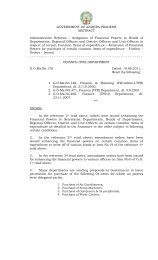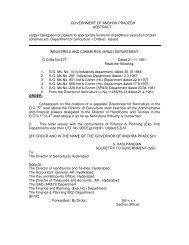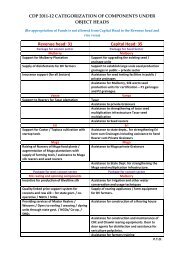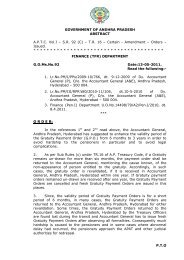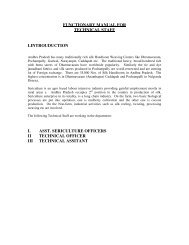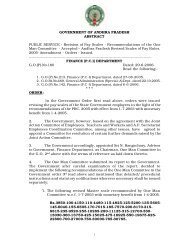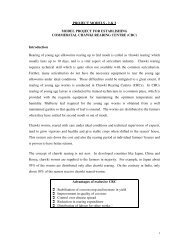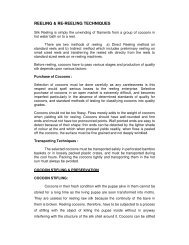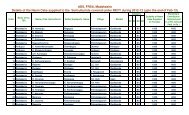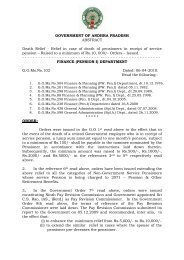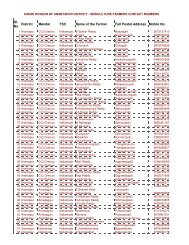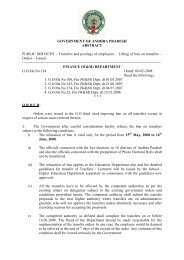FAQ down load PDF - Seri.ap.gov.in
FAQ down load PDF - Seri.ap.gov.in
FAQ down load PDF - Seri.ap.gov.in
- No tags were found...
You also want an ePaper? Increase the reach of your titles
YUMPU automatically turns print PDFs into web optimized ePapers that Google loves.
Frequently asked questions on Mulberry DiseasesS.No Question Answer43 What are the reasons for occurrence of powderymildew ?Powdery mildew is caused by the fungal pathogenPhyllact<strong>in</strong>ia corylea and is more common <strong>in</strong>temperate region. In tropics, it is common dur<strong>in</strong>gw<strong>in</strong>ter and ra<strong>in</strong>y season. Temperature 22-26C andRH of 60-70% favour the spread of disease. Thedisease is characterized by white powdery patcheson the lower surface of the leaves <strong>in</strong> the beg<strong>in</strong>n<strong>in</strong>g.As the disease advances, the patches spread to theentire leaf surface and turn to blackish brown <strong>in</strong>colour.44 How to control powdery mildew disease ? Improved aeration and sunlight <strong>in</strong> the mulberrygarden will help <strong>in</strong> check<strong>in</strong>g the spread of disease.Spray<strong>in</strong>g 0.2% Carathian or 0.2% Bavist<strong>in</strong>fungicides on the lower surface of the leaf will checkthe spread of disease. In highly disease proneareas it is advised to go for wider spac<strong>in</strong>g and toplant powdery mildew tolerant mulberry varieties.45 What are the measures to be taken to control leaf spot Lead spot disease <strong>in</strong> mulberry is caused by the?fungal pathogen Cercospora moricola. The<strong>in</strong>cidence of disease is more dur<strong>in</strong>g ra<strong>in</strong>y season.The diseased leaves have a number of circular orirregular brownish black spots of vary<strong>in</strong>g sizes..Serverly affected leaves become yellowish and fllprematurely.To check the spread of the disease, it is advisableto go for plantation with wider spac<strong>in</strong>g. The <strong>in</strong>fectedleaves must be collected and burn them. Twosprays of 0.2% Bavist<strong>in</strong> at an <strong>in</strong>terval of 10-15 days( safe period 4 days) will help to check the spread ofdisease.46 How to control root rot disease <strong>in</strong> mulberry ? Now a days root rot disease is becom<strong>in</strong>g veryserious and is caused by the fungus Fusariumsolani and F. oxysporum. The disease <strong>ap</strong>prears <strong>in</strong>all types of soil and climate throught the year. Thedisease <strong>ap</strong>pears <strong>in</strong> isolated patches <strong>in</strong> the gardenand spreads quickly to surround<strong>in</strong>g areas. Infectedplants show the symptoms of sudden wither<strong>in</strong>g ofleaves followed by dry<strong>in</strong>g / death due to decay<strong>in</strong>g ofrootControl measures:-1. As soon as the symptom <strong>ap</strong>pears, uproot the<strong>in</strong>fected plants and burn it. Remove the soil upto one foot from the <strong>in</strong>fected spot. Dust the pitswith 3-4 Dithan M-45 and plant new s<strong>ap</strong>l<strong>in</strong>gafter treat<strong>in</strong>g the root system <strong>in</strong> 0.1% DithaneM-45 solution for 30 m<strong>in</strong>utes.2. Raksha – a biofungicide developed by CSR&TI,Mysore for effective control. Mix 1 kg of Raksha(for 100 plants) with 50 kg FYM and store undershare for a week ma<strong>in</strong>ta<strong>in</strong><strong>in</strong>g 30% moisturecontent and <strong>ap</strong>ply the mixure @ 500 g/plantaround the root zone. While replant<strong>in</strong>g <strong>in</strong> thefailure pits, <strong>ap</strong>ply 500 g of mixure per pit, plantthe s<strong>ap</strong>l<strong>in</strong>gs treated with soil followd byirrigation.47 How to manage leaf rust ? Leaf rust is caused by fungal pathogen Ceratoliumfici. The disease is more common dur<strong>in</strong>g w<strong>in</strong>termonths. Infected leaves shows numerous p<strong>in</strong>headsize circular to oval brownish to black eruptive
sessions and later turns yellowish. In severe casesthe leaves wither off prematurely. The spread ofdisease can be controlled by timely utilization ofleaves and also by spray<strong>in</strong>g 0.2% Kavch (Chlorothalonil) or Folaf ( C<strong>ap</strong>tofol) 2 times at an<strong>in</strong>terval of 10-15 days ( safe period 4 days)48 How to control thrips <strong>in</strong> mulberry garden ? The <strong>in</strong>festation of thrips is frequent dur<strong>in</strong>g summerseason. Affected leaves shows streaks <strong>in</strong> the earlystage where as blotches are observed <strong>in</strong> advancedstage:Control measures:1. Spr<strong>in</strong>kler irrigation is found to be effective to killthe nymph and adults.2. Spray<strong>in</strong>g of DDVP at 0.2% concentration iseffective ( safe period 17 days)49 How to control ‘ Tukra” disease ? Tukra disease is caused by mealy bug (Maconellicoccus hirsutus) and is considered as themost serious pest of mulberry. The pest sucks thes<strong>ap</strong> from the tender leaves and shoots, whichresults <strong>in</strong> the malformation of the <strong>ap</strong>ical shoot. Theaffected plants show wr<strong>in</strong>kl<strong>in</strong>g of leaves, reduced<strong>in</strong>ternodal distance result<strong>in</strong>g <strong>in</strong> stunted growth andreduction <strong>in</strong> yield. The <strong>in</strong>cidence of tukra is severedur<strong>in</strong>g summer months.Control measures:1. Clipp<strong>in</strong>g the Tukra affected <strong>ap</strong>ical portion ofmulberry and burn<strong>in</strong>g it2. Keep the plot and its surround<strong>in</strong>gs free fromweeds, which may severe as host plants tomealy bug.3. Spray 0.2% DDVP prepared <strong>in</strong> 0.5% so<strong>ap</strong>solution after prun<strong>in</strong>g / harvest<strong>in</strong>g of plantstwice at an <strong>in</strong>terval of 10 days ( safe period 17days)4. Release predatory lady bird beetleCryptalaemus montrouzieri @ 250 adults/acre.50 How to control root knot disease <strong>in</strong> mulberry ? Root knot caused by a nematode, Meloidogynae<strong>in</strong>cognita is one of the most serious, and widelydistributed diseases of mulberry. It is moreprevalent <strong>in</strong> sandy soil under irrigated farm<strong>in</strong>gsystem. The disease is soil borne <strong>in</strong> nature andspreads through contam<strong>in</strong>ated s<strong>ap</strong>l<strong>in</strong>gs, implementsand cultivation of susceptible crops along withmulberry. The affected plants show stunted growth,marg<strong>in</strong>al necrosis and chlorosis of leaves. Theunder ground symptoms <strong>in</strong>clude the formation ofknots / galls on the rootsControl measures:As mulberry is perennial crop, it is difficult to controlthe disease by a s<strong>in</strong>gle method. Therefore,<strong>in</strong>tegrated <strong>ap</strong>proach is recommended.1. Apply neem / pongamia oil cake @2MT/ha/year <strong>in</strong> four split doses.2. Apply Bionema, a bionematicide of VerticilliumChlamydosporeum developmed by CSR & TI,Mysore. Mix 1 kg of Bionema with 24 kg Neemoil cake and 200 kg FYM and store for a week<strong>in</strong> shade ma<strong>in</strong>ta<strong>in</strong><strong>in</strong>g 30% moisture content.Apply the mixture @ 200 gr/plant around rootzoneand cover with soil followed by irrigation.
3. In severe cases, <strong>ap</strong>ply nematicide Furadan 3 G( Carbofuran) @ 40 kg/ha/year or Sebufos @30 kg/ha/year <strong>in</strong> four split doses for effectivecontrol of disease.51 How to control Bihar hairy caterpillar ? Spilarctia oblique or commonly called Bihar hairycaterpillar is a voracious eater and the <strong>in</strong>cidence isfrequent dur<strong>in</strong>g August to February. Each femalemoth lay 1000-2000 eggs <strong>in</strong> small batches, whichhatch <strong>in</strong> 5-7 days. Larvae pass six moults andpupate <strong>in</strong> soil.Control measures:-1. Collection and destruction of egg massesand gregarious young caterpillars.2. Deep plough<strong>in</strong>g and flood irrigation helps <strong>in</strong>expos<strong>in</strong>g and kill<strong>in</strong>g of pupae3. Spray<strong>in</strong>g 0.2% DDVP prepared <strong>in</strong> 0.5%,so<strong>ap</strong> solution on mulberry plants to kill thecaterpillars ( safe period 17 days)



